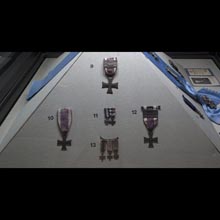
9. Cross of Valor with three bars and number “277” of division general Antoni Symon
Poland, Warsaw, 1920
10. Cross of Valor with number “44584” of division general Antoni Symon
Poland, Warsaw, 1920
11. Miniatures of the 5th class Order of Virtuti Militari and Cross of Valor with two bars
Poland, about 1921–1939
Gift of anonym from Lvov
12. Cross of Valor with three bars and number “50326”
Poland, Warsaw, 1920
13. Miniatures of decorations:
Independence Cross
Poland, 1930–1939
Cross of Valor
Poland, 1920–1939
Gold Cross of Merit
Poland, 1923–1939
exposition: Gallery „Arms and Uniforms in Poland",
The Main Building, 1, 3 Maja Av.
key: Faleristics <<<
The faleristics collection, which contains items datig from the 18th to the 20th centuries, is one of the largest in Poland and counts several thousand decorations and awards, many of them unique. It was founded in large part thanks to donations from such collectors as Emeryk Hutten-Czapski, Jadwiga Kulczyńska nee Estreicher, Anna Laskowska nee Wenzel, Matylda Janowska, Leon Kostka and Władysław Włoch. The most valuable are the unique Polish military and civillian decorations from the 18th and 19th centuries. Among them there are gold and silver medals of the order of Virtuti Militari from the first time it was awarded, Crosses and Stars of the Order of Virtuti Militari awarded from the period of the Duchy of Warsaw (among which is the Star of Virtuti Militari belonging to Prince Józef Poniatowski), from the period of the November Insurrection and from the period following the reinstitution of the award in 1920, as well as examples from the Second World War. Standing out among the civilian honours are the Order and Star of the White Eagle and of St Stanisław. A unique element of the collection is the Medalion of the Order of the White Eagle, presented to Russian fianance minister Peter Miatlev by King Stanisław Augustus Poniatowski in 1797. Some interesting honours in the collection are the chapter distinctions from the first Republic and also those created in the 19th century during the partitions of Poland, all of which come from the collection of Emeryk Hutten-Czapski.
Of extraordinary value is the collection of commemorative medals and badges related to the struggles for independence and boundaries between 1914-1920 as well as circumstantial and fund-raising decorations being an evident sign of great patriotism of Polish society.
The group of regimental (battalions) commemorative badges from the interwar period, sent to the National Museum as gifts, forms one of the most complete collection of its kind in Poland. Similar in magnitude is the collection of Polish military eagle cap insignia, which is currently the largest in Poland, ranging from the first Strzelca paramilitary organisations, the Polish Rifle Squads, Bartosz Squad to eagles worn in the Legions and in the reborn Polish Army.
Aside from the Polish orders, insignia, and decorations, the collection also contains French, English, German, Italian and some individual examples of Spanish, Turkish and Persian insignia. Notable in this collection are the commemorative insignia from the former Austro-Hungarian empire, in many cases belonging to citizens of Polish nationality who served in the Austiran civil service or the military.
Piotr Wilkosz











